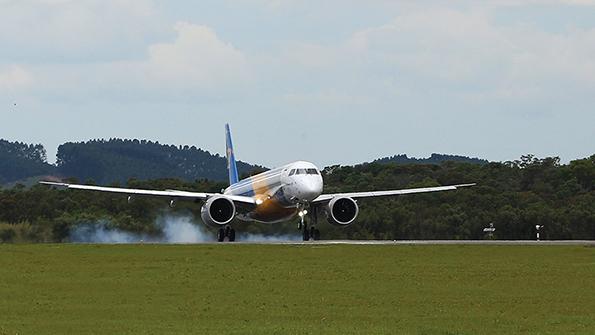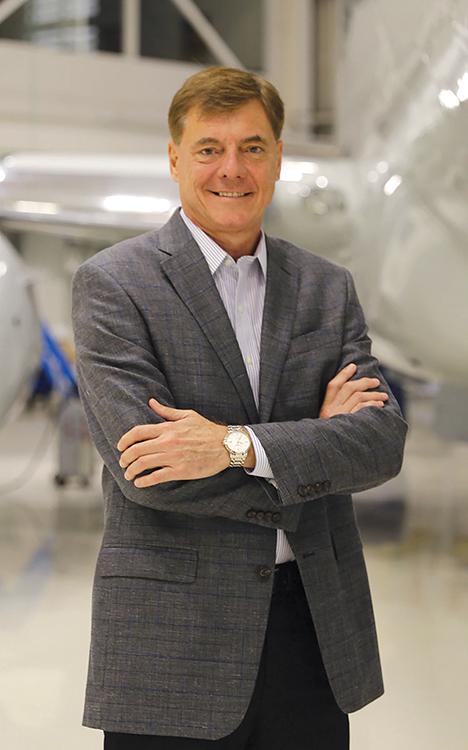
Embraer delivered 57 commercial jets in 2022, including 18 E195-E2s.
Francisco Gomes Neto was appointed president and CEO at Embraer in May 2019. In an exclusive interview with ATW at the company’s Sao Paolo headquarters, he talked about the manufacturer’s strategy and the importance of the Asia and China markets, the decision to suspend a plan for a new turboprop, and why he believes Embraer has emerged from the pandemic stronger, even though a new joint venture with Boeing collapsed in 2020.
– Interview by KURT HOFMANN
Embraer plans to deliver up to 70 aircraft this year versus more than 100 before the pandemic. What are your growth plans? We plan to grow double-digit every year and we believe, over the next four to five years, this will be a company with $7-$8 billion in revenues compared to $4.5 billion last year, with guidance for between $5.2 billion and $5.7 billion this year. This is with the existing portfolio of products. We want to produce 100 commercial aircraft again. Several sales campaigns are ongoing, in commercial as well as in defense. We have filled our production slots for 2024, which take into consideration limitations because of supply chain challenges, and we just need to deliver the aircraft. We continue to focus on innovation and efficiency. We delivered 57 [E-Jets] last year versus 45 in 2021. With our production cost reduction initiatives, we were able to be profitable last year even at 57 aircraft.

Do you have sufficient qualified employees to fulfill your targets? First of all, it is not only about having qualified labor; it is also about getting parts. We don’t have any issues in hiring new employees. We just have to increase production and then we will hire more employees. Embraer is a very attractive company. With the forecast of the global rebound in domestic and regional flights, 2024 will be back to pre-pandemic levels and we see more demand for aircraft. I believe in four years from now we will produce 100 aircraft again or even more, and commercial aviation will be an important contributor. Our infrastructure is ready, but the supply chain must improve. We think next year will be more normal.
The joint venture with Boeing was brief. Are you confident in how you proceed without that? We are in a retraction process. We expect a solution to be finalized by the end of this year or the beginning of next year. We have put in place a lot of initiatives to prove the efficiency and enhance the sales of our existing portfolio. We are lucky to have a portfolio of products that are very modern, including the E2, which we launched in 2018. Now is a good time; the airlines are starting to think about renewing their fleets. We are in a very good situation, and it is very realistic that in 2023 we will make more deliveries compared to 2022. I know the competition is hard, but I believe we have a very good product. So yes, we are a healthy company, we are reducing our debt, the company is performing much better and will become much stronger because of the plans and initiatives we have in place. The outlook is very good.
How do you see markets differing from region to region? In North America you have the [pilot] scope clause [restricting regional jet size]. When the pilot shortage issue is resolved, which we believe will be in 2026, we will have a good opportunity to continue to sell the E-175. We still see a chance in the US. [Toronto-based] Porter Airlines is another great example of market opportunity, with 50 E-Jets on order. This year will be the first where we will produce more E2 than E1s, so I think we have opportunities everywhere. In Asia, we just sold nine aircraft to [Singapore Airlines LCC subsidiary] Scoot, which opens up a very good opportunity. These aircraft serve the regional network with 10% more efficiency compared to the competition. And it is a sustainable solution with the best cost per seat. This has value. China is very important, and our market intelligence says that over the next 20 years Asia will need more than 2,200 aircraft, of which 1,400 will be for China. We have delivered almost 200 aircraft to China. It is time to be back in China with new sales and deliveries. Our market intelligence tells us that overall demand over the next 20 years for jets up to the 150-seat segment is about 8,500 units. If we get a part of that market, it will be enough to keep Embraer strong, profitable, and able to continue developing new aircraft and keep competing in the market. It is very important that competition is there for the customer. Can you imagine competition without Embraer? That would not be healthy. We are working on all the fronts.
Will Embraer ever offer a larger aircraft? This is the million-dollar question. We have the competence to do it, the in-house engineering—we know how to do aircraft. We have the E2 with new wings, new fuselage, new landing gear, fly-by-wire system, etc. How to fund a larger aircraft program, which would be a big program, is not yet decided. Let’s wait and see. At this point in time, we have a lot of other priorities. But this might be an opportunity for the future.
Embraer put a project to design and build a new turboprop on hold. Why and what’s next? We decided to put it on hold to find the right solution for the engines. We do believe there is potential demand for the aircraft, but we didn’t find the engines. But we have so many good opportunities at Embraer that we are discussing now with our engineers, the innovation team, finance. We want to work a little more on making the right decision about the next step. A turboprop is one of those opportunities, but we are working on all fronts. We are concentrating on two products. One is an electric-powered aircraft with between 19 and 30 seats. And if the customer wants more seats, we are looking at hydrogen and will develop this concept further through 2023, with the aim of being ready to announce something, maybe in 2024. We have a very good portfolio for the next five to six years, but we are working very hard to guarantee the future of Embraer with good product planning.





